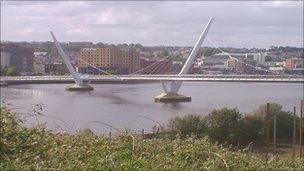New peace bridge is symbol of hope in 'stroke city'
- Published

The city's new bridge is the same length as two and a half football pitches
The city with two names now has three bridges.
At a cost of £14.6m, the new 'peace bridge' in Londonderry/Derry is the latest attempt to bring Protestants and Catholics closer together.
At the moment, most Protestants live on the east bank of the River Foyle, most Catholics live on the west bank. Some are reluctant to cross to the other side.
The idea is to try to bridge the gap.
The new bridge is 312 metres long - around the same length as two and a half football pitches. It is s-shaped, and from above it looks like a massive steel snake.
It is designed for pedestrians and cyclists, and stretches from Guildhall Square on the west bank to Ebrington on the east bank.
The question is - how many people will use it?
The past week in Northern Ireland has shown that sectarian tension is still simmering in a number of areas. It is not just a problem in east Belfast where two nights of rioting took place.
Many Catholics and Protestants still live largely separate lives. They live in different streets, study at different schools, play different sports, go to different bars and, of course, attend different churches.
In Londonderry/Derry - sometimes referred to as stroke city - the level of sectarianism is not as bad as it used to be.
The hope is that the new bridge will help to improve relations even further among its 100,000 residents.
That is certainly the view of the man who is in charge of keeping the peace in the city, Chief Superintendent Stephen Martin.
He said:"I was here in the 1980s as a police officer for six years - it is a fundamentally different place now.
"It is a place of hope, it is a place of increasing prosperity and it's a place where the people of the city want peace.
Dissident republicans
"Similar to some of the imagery we saw recently with the Queen's visit to the Republic of Ireland, and the reconnections and the bridges which that built, this bridge is very important."
However, it is being built in a city where dissident republicans have recently exploded a number of bombs. How big a threat do they pose in Derry?

Chief Superintendent Stephen Martin is in charge of keeping the peace in the city
Chief Supt Martin said: "There are a number of people in this city - anti-peace republicans - who are setting their face against the wishes of the overwhelming majority. They pose a threat and we must not underestimate that threat.
"But every day I see people in the communities working with each other, working with the police, seeking to build a better future and the overwhelming direction of this city is forward."
In many ways, Derry has been ahead of the game when it comes to tackling difficult issues.
It was here 20 years ago that the Nobel peace prize winner John Hume held secret talks to try to negotiate an IRA ceasefire.
Dialogue over contentious parades started in Derry before most other places, and political relations on the city council normalised long before they did 70 miles away on Belfast City Council.
The peace bridge took only 18 months to build. It was designed by Wilkinson Eyre Architects who also designed the Gateshead Millennium Bridge over the River Tyne.
Around 1,000 tonnes of steel were used in the construction, the equivalent of 143 double decker buses. The multi-million-pound funding came from the European Union's Peace III programme.
The reaction of the majority of people in Derry to the bridge has been positive. There is a warm feeling of civic pride.
At the same time, there have been some gripes. Some say it cost too much money, or complain that its lights waste too much electricity.
'Bendy bridge'
Others worry that after the novelty of it wears off, few people will use it. For some, crossing to the other side would amount to changing the habit of a lifetime.
Nonetheless, the bridge has attracted huge interest, and is seen by many as a powerful symbol of the new Northern Ireland.
It will offer the people who speak about better integration to walk the walk, not just talk the talk.
It is certainly a spectacular sight, snaking across the River Foyle, linking the two halves of the city.
Some call it the peace bridge, others call it the bendy bridge.
In this part of the world, it seems there are two names for everything.
- Published24 June 2011
- Published6 January 2011